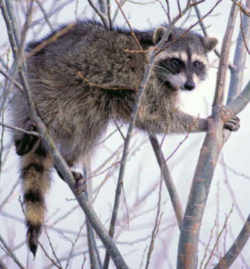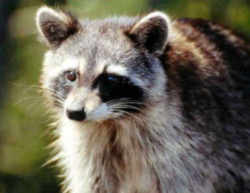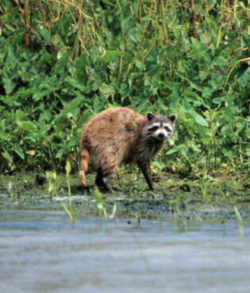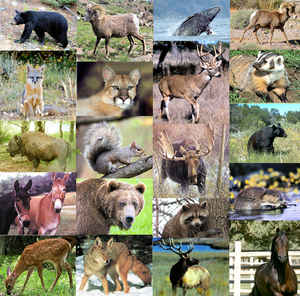
Oklahoma Symbols
Oklahoma State Furbearing Animal
Raccoon

(P. lotor)
Adopted on January 30, 1990.
The raccoon, (Procynn lotor,) is a furry animal that has a bushy, ringed tail and a band of black hair around its eyes which looks like a mask. It was adopted as the state furbearing animal on January 30, 1990. Raccoons, often called coons, eat fish and frogs that they catch in rivers and streams. Raccoons living in Tennessee measure from 30 to 38 inches long, including their tails. They weigh from 12 to 25 pounds. Most males are larger than females. Raccoons walk like bears, with all four feet on the ground, and are good swimmers.
Oklahoma State Furbearing Animal: Raccoon

The raccoon sometimes spelled racoon, also known as the common raccoon, North American raccoon, northern raccoon and colloquially as coon, is a medium-sized mammal native to North America. The raccoon is the largest of the procyonid family, having a body length of 40 to 70 cm (16 to 28 in) and a body weight of 3.5 to 9 kg (8 to 20 lb). Its grayish coat mostly consists of dense underfur which insulates against cold weather. Two of the raccoon's most distinctive features are its extremely dexterous front paws and its facial mask, which are themes in the mythology of several Native American tribes. Raccoons are noted for their intelligence, with studies showing that they are able to remember the solution to tasks for up to three years. They live in a variety of habitats, including marshes, forests, prairies, cities, and suburbs. These nocturnal (most active at night) animals have a life span of about 6 years in the wild.
Characteristics of the Raccoon
Anatomy

Raccoons are easily recognized by their grayish, salt-and-pepper bodies with a black mask over the eyes and rings around the tail. Often these rings are less defined on the underside of the tail. The fur is long and soft with dense underfur in the winter and thick guardhair on the back and around the tail at all times of the year. Young are colored similarly to adults, except that the top of the head, nape of the neck, and area behind the ears are brownish black, whereas these areas on adults are lighter. In general, the more northern raccoons have longer and darker coats. They have a bushy, black-ringed tail, clawed feet, and a pointed snout. They have long fingers and toes and an acute sense of touch. The hind legs and feet are generally dark brown to black. There are five digits on each foot, each with a non-retractile claw. The raccoon leaves a distinct hand-like print on soft ground that can occasionally show the individual toes. Newborn raccoons do not have black eye patches or a ringed tail; these develop after a few days. Raccoons grow to be about 18 to 26 inches (46-66 cm) long plus a striped, furry tail 9 to 12 inches (23-30 cm) long.
Females have six mammae, arranged in three pairs in the pectoral, abdominal, and groin areas. Males have a long, curved baculum.
Raccoons generally live ten years of more in the wild and may live even longer in captivity. The oldest known raccoon was a female aged 12 years and 7 months at death.
Diet
Raccoons will eat almost anything including nuts, fruits, berries, grass, leaves, seeds, insects, crustaceans, worms, eggs, fish, some small mammals, kitchen scraps, and garbage. Raccoons will even get into trash cans and live primarily off food scraps found there. Raccoons find much of their food in water.
Reproduction
In the eastern United States, raccoons mate in February and March, and the young are born in April and May after a gestation period of 63-70 days.
There are generally two to seven young per litter, and the average litter contains four young. Although the young are covered with hair at birth, their
eyes do not open for about nineteen days. The young are weaned at about six weeks but remain with their mothers into the autumn. Some young remain
with their mothers until the next breeding season. Raccoons reach adult size and sexual maturity around two years of age. Some may mate before they
reach maturity, but these matings rarely produce offspring.
The raccoon has a bipart uterus, with two full uterine horns. Trans-uterine migration occurs in the raccoon where embryos conceived from the eggs produced
in one ovary migrate to the uterine horn on the opposite side. Trans-migration allows the raccoon to support more embryos in the uterus. Also, ovulation
in raccoons does not occur until after copulation. This characteristic is advantageous because raccoons do not waste metabolic energy on ovulation
until mating has actually occurred.
Habitat
In the wild, raccoons are found primarily along streams and lakes near wooded areas. However, raccoons are opportunists and may inhabit urban, residential, and recreational areas. Raccoons are not particular about den sites and may use tree hollows, hollow logs, caves, rock crevices, holes in the ground, and sometimes even storm sewers.
Raccoons are nocturnal, though they may leave their dens during the day to bask in the sun or forage for food. The home range of an adult male may be as large as 3.2 km (2 mi.) And as small as 18.2 hectares (45 acres), with an average range of 204 hectares (504 acres). It is estimated that female and juvenile ranges are approximately half this average size. In suburban areas, home ranges seldom exceed 3.2 hectares (8 acres).
Oklahoma Concurrent Resolution 25
Senate Concurrent Resolution No. 25
A Concurrent Resolution proclaiming the raccoon as the Official Furbearer of the State of Oklahoma; and directing distribution.
WHEREAS, the raccoon is Oklahoma's most important furbearing animal, both economically and recreationally; and
WHEREAS, in the crisp, cool nighttime, "coon hunting" is an exciting sport for many outdoorsmen who enjoy following the sound of baying hounds through
the fields; and
WHEREAS, "coon hunting" is a legendary part of Oklahoma's recreation.
Now, Therefore, be it resolved by the Senate of the 1st Extraordinary Session of the 42nd Oklahoma Legislature, the House of Representatives concurring
therein:
THAT the raccoon is hereby designated as the Official Furbearer of the State of Oklahoma.
THAT a copy of this resolution be distributed to the Governor, the Lieutenant Governor and the Chairman of the Wildlife Conservation Commission.
Adopted by the Senate the 25th day of January, 1990.
Adopted by the House of Representatives the 30th day of January, 1990.
Filed with the Secretary of State January 30, 1990.
Taxonomic Hierarchy: Raccoon
Kingdom: Animalia
Phylum: Chordata
Class: Mammalia
Order: Carnivora
Family: Procyonidae
Genus: Procyon
Species: P. lotor







